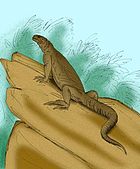| Revision as of 19:28, 2 January 2025 editIJReid (talk | contribs)Autopatrolled, Extended confirmed users, Pending changes reviewers, Rollbackers12,843 edits stub | Revision as of 19:28, 2 January 2025 edit undoIJReid (talk | contribs)Autopatrolled, Extended confirmed users, Pending changes reviewers, Rollbackers12,843 editsNo edit summaryNext edit → | ||
| Line 20: | Line 20: | ||
| ] | ] | ||
| ] | ] | ||
| ] | |||
Revision as of 19:28, 2 January 2025
Extinct genus of lizards
| Aciprion Temporal range: Oligocene PreꞒ Ꞓ O S D C P T J K Pg N | |
|---|---|
| Scientific classification | |
| Domain: | Eukaryota |
| Kingdom: | Animalia |
| Phylum: | Chordata |
| Class: | Reptilia |
| Order: | Squamata |
| Suborder: | Iguania |
| Family: | Iguanidae |
| Genus: | †Aciprion Cope, 1873 |
| Type species | |
| †Aciprion formosum Cope, 1873 | |
| Synonyms | |
| |
Aciprion is an extinct genus of lizard from the Middle Oligocene of Colorado, Wyoming and Nebraska. It was named in 1873 by American paleontologist Edward Drinker Cope for a jaw fragment from the Cedar Creek Member of the White River Formation in Colorado, as the binomial A. formosum. Multiple additional specimens have been referred to the genus, including the second species A. majus named by Gilmore in 1928 for a partial skull. However, the differences between A. formosum and A. majus relate to slight size differences, so A. majus is considered a junior synonym of A. formosum. Cope originally named Aciprion as a genus of teiid lizard, but Gilmore reclassified it as a member of Iguanidae.
References
- ^ Estes, R. (1983). "Part 10A. Sauria terrestria, Amphisbaenia". In Kuhn, O. (ed.). Handbuch der Palaoherpetologie. Gustav Fischer Verlag. p. 210.




